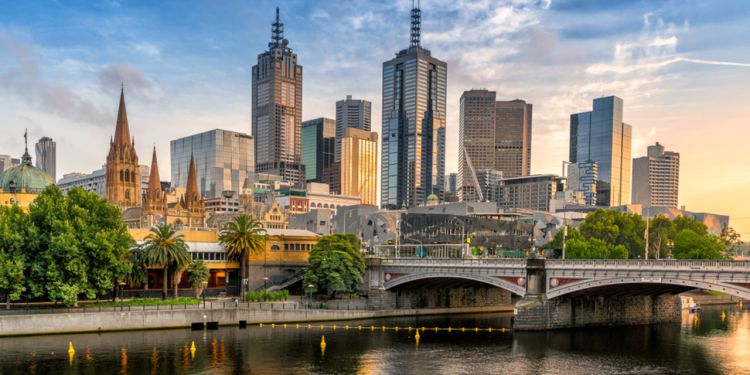Discover Melbourne

The vibrancy and excitement of Melbourne resonates through its arts, food, and creative scene. Melbourne's rapid growth is paving the way for it to dethrone Sydney as Australia's largest city. It's no wonder that the foodie culture, art scene and relaxed lifestyle is attracting international students to Melbourne and expats from around the world in droves.
The climate in Melbourne
Melbourne is the capital of the state of Victoria and is located in the southeast region of Australia. The climate is subtropical oceanic with frequent winds and very hot summers. A common misconception is that Melbourne is hot all year round because it is in Australia. This couldn't be further from the truth, and perhaps it's due to climate change, but you will find winter cold in Melbourne. Because of the icy air masses surrounding Antarctica, the temperature can swing quickly. Ask any Melbourne resident about the weather in their city, and they will tell you that sometimes you will experience four seasons in one day! Whatever the season, always carry an umbrella, a raincoat and be prepared to shed layers of clothing once the sun is out.
The hole in the ozone layer explains Melbourne's scorching summers with temperatures that can reach 42°C. Wearing sunscreen is absolutely imperative and don't consider going out on hot days without any protection or you will suffer the consequences. The best time to visit Melbourne is during the hot and sunny summer from December to February.
Spring is known to be a little wetter as the season moves into the hot summer months. It is best to bring a warm jacket if you are visiting in the spring (September to November) or fall (March to May). Autumn is also a pleasant time of year, when nature becomes more colorful and the temperatures are still warm, but the nights are cooler.
Social life in Melbourne
A city as thriving as Melbourne has a full calendar of events throughout the year. The best time to enjoy the bars and restaurants in Melbourne is undoubtedly in the summer, when they are overflowing with people enjoying the sunny terraces. In summer, the riverside bars and resturants are filled with people enjoying their social time, city parks are also very popular for picnics, socialising and enjoying the warmth.
In winter, the colder weather doesn't inspire much enthusiasm and Melburnians tend to retreat to the warmth of their homes. This is a great opportunity for you to try some of the trendy restaurants that are usually crowded.
Melbourne is a city that thrives on seasonal events and festivals. For example, the Queen Victoria Market (QVM) is open year-round, but hosts a summer night market from November to March and a winter night market from June to August.
Melbourne hosts many international events throughout the year that attract visitors from all over the world, such as the Australian Open (summer), the Melbourne International Comedy Festival (March/April) and the Formula 1 Grand Prix (March).
The nature in Melbourne
Melbourne is a metropolis, but if you want to escape the hustle and bustle of the city, there are many city parks and beaches to choose from. From the Royal Botanic Gardens in the city center to Fitzroy Gardens, there are plenty of options to reconnect with nature.
St Kilda and Brighton Beach, south of the city, are popular beaches, but if you're willing to do a bit of a commute around Melbourne, explore the Mornington Peninsula. Explore the charming seaside villages, relax at Martha or Sorrento Beach or escape to the wine country.
Victorians love to surf and you'll find several beaches along the coast where you can surf. However, the perilous currents and steep waves, where surfing is popular, are not to be taken lightly. It is safer to swim between red flags, where lifeguards are patrolling, and it is advisable to refrain from swimming if there is no one on the beach.
On the outskirts of Melbourne, you'll find breathtaking scenery, from the vineyards of Red Hill and Yarra Valley to the Grampians National Park. Soak up Victoria's natural beauty and discover its flora and fauna, just a few hour's drive from the city.
Cost of living in Melbourne
There is no denying that Melbourne is an expensive city and that the cost of living is rising along with the price of residences. The cost of living in Melbourne is ranked 85th out of 578 cities worldwide. The estimated monthly cost for a single person is $1,371, excluding rent. Expenses include rent, food, clothing, entertainment and transportation. Nevertheless, there are still many people who manage to live relatively comfortably in Melbourne on average salaries. And it is important to keep in mind that while Melbourne is an expensive city, it offers high wages by international standards.
The national minimum wage is currently $20.33 per hour or $772.60 per 38 hour week (before tax).
The practice of budgeting should not be underestimated and a good habit to adopt is to shop at local markets and avoid eating at restaurants all the time. Compare gas and electricity prices to find the most cost-effective ones, and remember to look for everyday discounts and deals, such as special rates for students or children, or cheaper movie tickets on weekdays.









